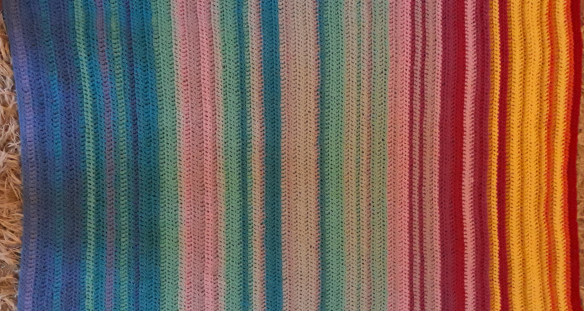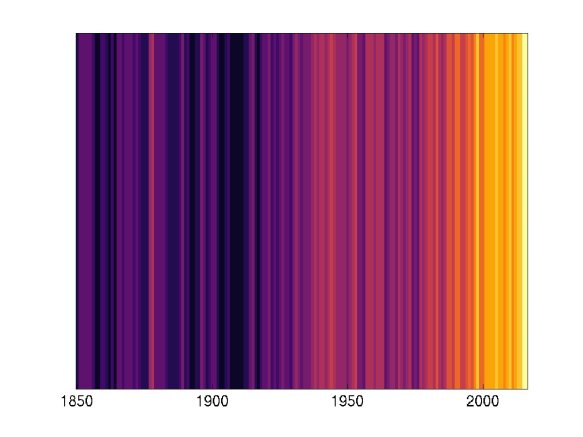My most popular blog to date has been on the combination of crochet and climate change data, but crochet is relevant to the teaching and learning side of my working world too. Having taken part in a variety of Crochet ALongs (CALs) in recent years, and having interest in the broader issue of social learning as educationalists, Professor Shirley Williams and I reflect here on the history of craft-alongs, and their place in the evolution of learning towards becoming more informal and more social.
Crochet’s resurgence 
Crochet has undergone a revival recently, especially in relation to the benefits of crochet (and knitting) for relaxation. There are even books and articles on mindful crochet and crochet therapy. However, there is no clear evidence of the origins of crochet (Marks, 1997), although there are a number of theories of origins ranging through developments in Arabia, China to South America. Certainly crochet came to popularity in Europe during the nineteenth century, Potter (1955) cites Caulfeild and Saward’s “Dictionary of Needlework” dating its popularity to 1838, with even Queen Victoria crocheting (Canadian War Museum, n.d.).

One of eight scarves Queen Victoria crocheted for presentation to members of her forces fighting in South Africa. This is the scarf awarded to Private R.R. Thompson on display at the Canadian War Museum. Photo from Canadian War Museum Ottowa
Developments in various countries have led to different ways of identifying hook sizes, and to multiple names for the same stitch, including some terms used in both US and UK crochet referring to different stitches. There is no worldwide standard for abbreviations of crochet terms and corresponding symbols (Hazell, 2013). Thus the world of crochet has its own terminology and “jargon” that needs explanation to the beginner similar to academic disciplines, and perhaps lends itself particularly well to social learning.
Crafters, the internet and the birth of online Craft-alongs
A Craft-along is a group of crafters working, initially simultaneously, on their own realization of the same piece of work. Facilitated by the internet, participants work together on their own instantiation of an artifact (such as a crochet blanket), following instructions available online and sharing their experiences across an Internet platform such as Facebook, many participations start as soon as an along is launched, but completion times vary. Craft-alongs are usually called by the name of the craft involved; crocheters join crochet alongs (CALs), while knitters join knit alongs (KAL).
In fact, crafters in general were early adopters of the Internet, establishing and using Usenet groups, with lists such as alt.sewing and rec.crafts.textiles in the early 1990s (Rheingold, 2000). In 1998 a book was published “Free Stuff for Quilters on the Internet” (Heim & Hansen, 1998) and subsequently revised in a second and third edition, variants of the books were produced for other crafts (for example a version for a range of needlecrafts (Heim, 2003)). By 1998 it is reported quilters were using the Internet to collaborate on designs (Williamson, Glassner, McLaughlin, Chase, & Smith, 1998), while the Knitting Bloggers NetRing was established in early 2002 (Wei, 2004). Kucirkova and Littleton (2015) use the term “Community-Oriented Digital Learning Hub” (DLH) to describe online communities such as the yarn based Internet site Ravelry (Humphreys, 2009; Ravelry, n.d.) where members share their guides and patterns (“how to guides”) before and after the production of the artifact, and the community can “like”, comment and develop supplementary materials.
Many of these communities are examples of technology-enabled communities of practice (Le Deuff, 2010; Wenger, White, & Smith, 2009) using varied Internet-based resources and products as the home for individual communities; these technologies have changed considerably over recent years and some of the products used by early communities are no longer available (Wenger, 2001; Wenger et al., 2009). In one of the few texts combining craft and the digital world, Gauntlett (2011) suggests both that: Web2.0 offers a platform on which to share creative artifacts, and that creative projects are invaluable for human happiness.
Within the literature Brown and Brown (2011) dated the emergence of the term “knit along” to 2003/4:
“The term knitalong emerged out of the Internet knitting culture of blogs and discussion groups around 2003 and 2004, when it was used most often to describe the practice of knitters in different place working on the same project during the same time period.” (page 7)
While Wei (2004) identified the term as in use by bloggers in the period 2002/3. The emergence of the term in relation to other crafts is not possible to establish from the literature, but within social media hashtags including quiltalong, knitalong, crochetalong are now in widespread use.
We should also note that some people (Brown & Brown, 2011) use the term knitalong to refer to events which are purely physical, such as meetings of knitting groups in cafes and pubs; elsewhere (Minahan & Wolfram Cox, 2006) the term stitch’n bitch is used to describe physical and virtual groups in which knitters exchange ideas, resources and chat, while other authors (Kelly, 2014) use this term for only physical groups. The term stitch’n bitch was used as a title for a book (Stoller, 2003), some credit this as the origin of the term (Minahan & Wolfram Cox, 2006), however the use of the term pre-dates the book, for example Castleton (1990) mentions:
“…a monthly “Stitch ‘n Bitch” get-together with friends…” (page 95),
but the term became more widely use after Stoller’s book was published. However, we focus on internet based alongs in our consideration of the social learning aspects.
Crochet alongs as mass social learning.

Completed Dances on the Beach CAL involving learning several different types of stitches. Completed by Ellie Highwood, 2017
At any one time there are many “alongs” in various stages of maturity on the internet. Ravelry (Humphreys, 2009; Ravelery, n.d.) lists over 2500 Alongs (562 of which are classified as active), with 1484 knitalongs (467 active), 302 crochetalongs (95 active), and a small numbers of other crafts. A study in 2012 (Orton-Johnson, 2014) noted that amongst respondents each belonged to an average of 2 CALs on Ravelry. The closed Facebook group: CAL – Crochet A Long (n.d.) has some 45,000 members and lists about one new CAL a month, each with hundreds or a few thousand “guests” registered, many of these CALs also have a presence elsewhere on the Internet. This group serves as a focus allowing people to continue following CALs, and crucially learning from the CAL, outside the official time period. At any one time, people on this group are working on both current CALs and those from several years ago.
Learning takes place usually after provision of initial material (pattern) which is sometimes released in sections, and usually involving the course initiator(s), and a much larger group of participants. Learning includes not only the techniques and terminology, but colour combinations and yarn choice. Participants often provide translations of patterns (officially sanctioned or otherwise), and some provide videos of particularly challenging sections. Very rapidly, learning and teaching is spread across a vast group of participants.
Interestingly, this type of relatively informal, social, learning also occurs in Massive Open Online Courses (or MOOCs) which cover a wide range of subjects, and usually involve awareness raising, knowledge and skill transfer, but rarely involve the production of a physical artefact. CALs and MOOCs share some characteristics, but also can learn from each other. We are writing a more academic comparison of crochet-alongs and MOOCs for publication in a social learning journal.
References
Brown, L., & Brown, M. J. (2011). Knitalong: Celebrating the tradition of knitting together: Open Road Media.
CAL – Crochet A Long. (n.d.). Facebook [Group]. Retrieved from https://www.facebook.com/groups/668646249929007/
Canadian War Museum. (n.d.). Canada & The South African War, 1899-1902 : The Queen’s Scarf of Honour. Retrieved from http://www.warmuseum.ca/cwm/exhibitions/boer/queensscarf_e.shtml
Castleton, A. (1990). Speaking out on domestic violence. Dialogue: A Journal of Mormon Thought, 23, 108-115. Gauntlett, D. (2011). Making is connecting: Polity Press.
Hazell, S. (2013). 200 Crochet Stitches: Search Press.
Heim, J. (2003). The Needlecrafter’s Computer Companion: Hundreds of Easy Ways to Use Your Computer for Sewing, Quilting, Crossstich, Knitting, And More! : No Starch Press.
Heim, J., & Hansen, G. (1998). Free Stuff for Quilters on the Internet: C & T Publishing.
Humphreys, S. (2009). The economies within an online social network market: A case study of Ravelry.
Kelly, M. (2014). Knitting as a feminist project? Paper presented at the Women’s Studies International Forum.
Kucirkova, N., & Littleton, K. (2015). Digital learning hubs: theoretical and practical ideas for innovating massive open online courses. Learning, Media and Technology, 1-7. doi:10.1080/17439884.2015.1054835
Le Deuff, O. (2010). Réseaux de loisirs créatifs et nouveaux modes d’apprentissage. Distances et savoirs, 8(4), 601-621.
Marks, R. (1997). History of Crochet. Chain Link Newsletter, reproduced at http://www.crochet.org/?page=CrochetHistory
Minahan, S., & Wolfram Cox, J. (2006). Making up (for) society? Stitch, bitch and organisation. Paper presented at the ANZAM 2006: Proceedings of the 20th Australian and New Zealand Academy of Management Conference.
Orton-Johnson, K. (2014). Knit, purl and upload: new technologies, digital mediations and the experience of leisure. Leisure Studies, 33(3), 305-321.
Potter, E. (1955). English Knitting and Crochet Books of the Nineteenth Century. The Library, 5(1), 25-40.
Stoller, D. (2003). Stitch’n bitch: The knitter’s handbook: Workman Publishing.
Wei, C. (2004). Formation of norms in a blog community.
Wenger, E. (2001). Supporting communities of practice. Retrieved from https://guard.canberra.edu.au/opus/copyright_register/repository/53/153/01_03_CP_technology_survey_v3.pdf
Wenger, E., White, N., & Smith, J. D. (2009). Digital habitats: Stewarding technology for communities: CPsquare.
Williamson, M. B., Glassner, A., McLaughlin, M., Chase, C., & Smith, M. (1998). Constructing community in cyberspace. Paper presented at the CHI 98 Conference Summary on Human Factors in Computing Systems




